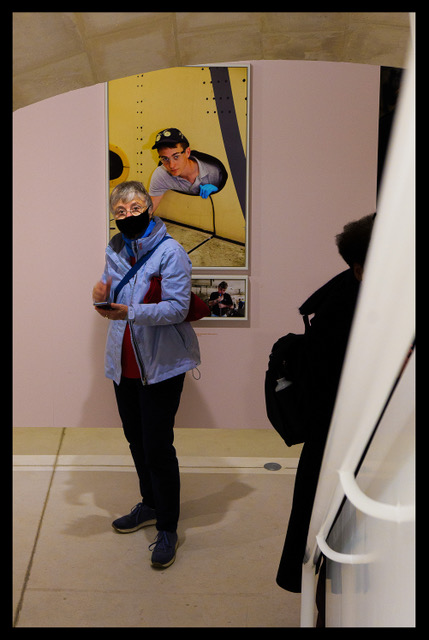“RECONCILIATION”
Wrapped in the joyous colors of Martin Parr and imbued with Henri Cartier- Bresson’s timeless portraits of humanity, RECONCILIATION is a satisfying last-minute holiday gift to yourself, alone or accompanied… and it’s up through January 29. The exhibition opened in November, launching an additional exhibition space called “The Tube” created by renovating an 18th century cellar located beneath the existing Fondation HCB at 79 Rue des Archives, 75003 Paris, France.
The style of the two photographers is as opposite as can be: in the words of Cartier-Bresson, they come from “two separate solar systems.” Parr’s saturated, often garishly-colored images of the northern English working and middle classes document that population “at work and at play” during three different time periods: the early 1960’s, the mid ‘80s, and after 2010. Through his lens we see the bumpy transformation of working-class England from a grim, Dickensian manufacture-based economy to an awkwardly burgeoning service economy, with all the confusion and social upheavals such change engenders.

A spectator examining prints by Henri Cartier-Bresson, Blackpool, 1962. Photo by Judith Bluysen
In 1963 Cartier-Bresson was commissioned to document “the English” for a short film by Douglas Hickox, “Stop Laughing—This is England”. He photographed the working classes “summering” at the Northern seaside resort of Blackpool, and then back to work in autumn in the industrial towns of Liverpool, Manchester and Sheffield. The film, and the photographs it contained, received little attention at the time, but in 2021 the Cinémathèque Française unearthed it from their archives. The film is shown here on the ground floor (20 minute length), with some commentary by Cartier-Bresson himself, and some of the photographs have been printed and are exposed downstairs in The Tube. It’s an interesting juxtaposition of modest, classic B&W Cartier-Bresson on the long wall to the left of the entrance facing another wall of large, vibrant Parr prints with rows of smaller 8x10s below them: rounding the corner, a second space with a similar configuration leads back to the staircase.

A spectator examining prints by Martin Parr, circa 2012. Photo by Judith Bluysen
The contrast of Parr and Cartier-Bresson’s visions of the same populations reflect the disparity of their styles and perhaps their visions of humanity. Cartier-Bresson was born into the haut-bourgeoisie, yet his images are imbued with a tenderness that grants beneficence to the spirit of people from all walks of life. Both at work and at leisure, his working-class subjects evoke a resigned dreaminess even in bleak factory settings. His photographs reveal the inner, intrinsic attributes of his subjects, while Parr’s images showcase the external devices of the people or populations he photographs: choices of costume, warpaint (make-up, hairstyles, tattoos), accessories, and comical facial expressions. And it is often extreme: as Cartier-Bresson remarks in the film, “ (the English) are as exotic as can be!”. Parr’s work is not intentionally cruel but can easily evoke either derision or a sympathy based on perceived superiority, a patronizing snort. However, the ambiance in the Tube was light both times I visited; rarely do I see so much animated discussion and smiles among viewers at an exhibition.
 Glass cases allow perusal of elements of the “feud” between Henry Cartier- Bresson and Martin Parr. In 1989, already well-know for his color photographs of the British middle class and the photobook “The Last Resort”, Parr applied to the Magnum agency for membership. Cartier-Bresson, one of the co-founders of Magnum, vehemently opposed it initially, but after meeting Parr, he took into account the opinions of other members and finally acquiesced, despite his legendary dislike of color photography. His was the deciding vote, hence the title “Reconciliation”. Hand-written notes, faxes and correspondance between Cartier-Bresson and Martin Parr are displayed and add to the drama of the exhibition.
Glass cases allow perusal of elements of the “feud” between Henry Cartier- Bresson and Martin Parr. In 1989, already well-know for his color photographs of the British middle class and the photobook “The Last Resort”, Parr applied to the Magnum agency for membership. Cartier-Bresson, one of the co-founders of Magnum, vehemently opposed it initially, but after meeting Parr, he took into account the opinions of other members and finally acquiesced, despite his legendary dislike of color photography. His was the deciding vote, hence the title “Reconciliation”. Hand-written notes, faxes and correspondance between Cartier-Bresson and Martin Parr are displayed and add to the drama of the exhibition.

A Parr-ish view of the entrance to the exhibit, with a Parr photo in the background. Photo by Judith Bluysen
I admit to approaching this show with a mild and lukewarm curiosity. Martin Parr’s work has always struck me as more Three Stooges than Charlie Chaplin, but the opportunity to see little-known Cartier-Bresson prints finally convinced me to go last week. I left the exhibit with the usual heartthrob for the Master, but also with a newfound respect and yes, admiration, for Martin Parr, who had written to Cartier-Bresson “I acknowledge there is a large gap between your celebration of life and my implied criticism of it (but) why shoot the messenger?”
Why indeed…
This article about the exhibition RECONCILIATION is by Judith Bluysen, a relapsed street photographer now shooting in Paris. Check out her website www.judithbluysen.com, or on Instagram @luluparee and her other articles:
The photos for this article were taken during the author’s two visits to the Reconciliation exhibition.


